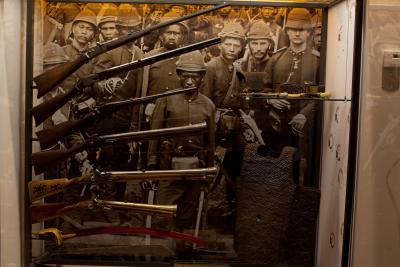Hidden Atrocities
This photograph was taken in 1898 at Pedir, during the violent Aceh-war (1873-1908) on Sumatra, the Netherlands-Indies, when Royal Netherlands-Indies Army (KNIL) photographers took a number of images of military expeditions that committed massacres. In the course of the twentieth century these Aceh-war photos have become what Paulus Bijl has coined “emerging memories”: difficult and forgotten memories that resist narrativization and never acquired consensus about their meaning. They emerged several times in Dutch publications throughout the colonial and postcolonial era, to become “forgotten” after some time and appear again and again.
After Indonesia’s independence Dutch presence in the East was relegated to a dark corner of national history, ostensibly forgotten. Nonetheless, as the absent text of history, colonial memories lingered on in the margins of national discourses and the colonial past became a well-preserved “family secret”. The amnesia prevailing in the public domain perpetuated colonial representations of an idyllic and at the same time proud era. From the 1960s on, tempo doeloe nostalgia emerged as its dominant frame. Tempo doeloe, meaning “the good old days” in Malay, and referring to a pleasant and beautified Netherlands-Indies, collided in 1969 with public accusations of war atrocities committed by Dutch soldiers in the war of Indonesian Independence. As these accusations were broadcasted through television, they were widely disseminated and followed by shameful and guilt-ridden discourses about violence, exploitation and racism in the colony. This was nonetheless not the first time colonial atrocities were unveiled. Since 1904, and anew after 1945, visual memories pertaining to colonial atrocities have emerged again and again to upset the Dutch public.
One of the early Aceh-war photographs has emerged once more in the exhibition of the Indies Center of Remembrance (IHC Arnhem, The Netherlands) that opened in 2010. The IHC is a community based Center of Remembrance set up for the heterogeneous group of postcolonial migrants who came to the Netherlands after Indonesia’s Independence (1945). The Indies-Dutch group consists mostly of “repatriates” of mixed Indonesian and European descent as well as their children and grandchildren born in the Netherlands. As one of the four Centres of Remembrance of the Second World War in the Netherlands, this is the only one that focuses on the war in the Pacific. In 2010 it found accommodation in Bronbeek, a home for elderly KNIL-veterans which includes a military museum.
Shown in a glass case the photograph is part of a mixed media exhibition, called The Story of the Netherlands-Indies, developed by IHC and the military museum Bronbeek together. In the exhibition military colonial history and Indies remembrance of the colonial past have merged, with photographs playing a decisive role through affect. The photograph of atrocities committed during the Aceh war emerges in one of two opposite glass windows offering the viewers an Indonesian as well as a Dutch perspective on the war. The visual narrative that is told through the Dutch window relates to the objects that it has on display: conquered weapons, mainly rifles and sabres, and the photograph enlarged to fill the background. The ‘original’ print of the Pedir expedition, which in 1898 was taken by the well-known professional photographer C.B. Nieuwenhuys belongs to the Dutch Tropenmuseum. This ‘original’ print represents a crowd of Dutch colonial soldiers posing with bared weapons behind the bodies of dead Indonesians which lie scattered on the ground. Clearly visible, one of the soldiers, who shows his gun and sabre, has his foot on a dead man’s body, as a hunter’s trophy. In the IHC window only a small, blown up part of the original print is shown.
By cropping, and enlarging the remaining image the piles of dead bodies have been removed. The soldier with his foot on a corpse is however still in the picture. Yet, it is difficult for viewers to notice what he is doing, owing to the fact that a suit of armour – which is not in the photo - has been placed in front so that the shocking detail is hidden from view. Neither captions nor other forms of explanations inform the visitors about the origin, the previous ‘life’ or other publications of the photograph. The window therefore allows viewers to look at a past, but keeps them outside, at a distance, as if to prevent an active engagement with what is happening behind the pane of glass. What the viewer is presented with is heroism without atrocities, although many will remember the full content of the photograph. Framed and reframed by changing discourses, this image, with other Aceh-photographs, has been given varying, even opposite meanings in different contexts. The way the photograph is used in the context of Indies remembrance and military history demonstrates how, in the Netherlands, nostalgic and guilt-ridden discourses on the colonial past have always been effectually separated and do not interact.
Pamela Pattynama
